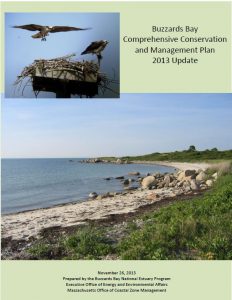2013 CCMP, Chapter 3:
Characterization of Pollution Sources
About the new Buzzards Bay CCMP Action Plans
The Buzzards Bay Comprehensive Conservation and Management Plan (CCMP) was updated in November 2013 to reflect the great progress achieved since the original CCMP was finalized.
You can download the entire document (buzzards-bay-ccmp-2013-update.pdf). This page has only a few highlights of this chapter. Read the actual text of Chapter 3 as a pdf file (1.3 MB), with graphics.
Chapter 3: Characterization of Pollution Sources
Overview
Buzzards Bay remains an estuary in transition. The stresses faced by Buzzards Bay are typical of the stresses placed on many estuaries of the northeastern United States from past dumping of wastes, new development, and conflicting uses of natural resources. Along the eastern and northern shores of Buzzards Bay, dramatic coastal development occurred in the 1980s and 1990s. Owners converted small summer vacation homes into yearround residences. Property owners built an even larger number of new homes in some of these summer cottage areas. In the late 1990s and early 2000s, communities on the western shores like Westport, Dartmouth, and Mattapoisett had their own similar growth booms. In contrast, areas like the City of New Bedford, an old industrial and fishing center has had both a severe and continued population and economic decline, in part contributing to the suburban growth patterns in the surrounding communities.
Like many old industrial centers, the greater New Bedford area suffered from decades of pollution. While areas of New Bedford inner and outer harbor and Clarks Cove have seen some dramatic improvements in water quality, this area of Buzzards Bay still faces decades of prescribed cleanup and restoration.
In contrast to the success stories around New Bedford, most development growth areas around the bay have largely experienced only continued water quality declines during the past two decades. Most of this degradation has been the result of nonpoint source pollution, and regulators have not imposed solutions, nor have towns adopted solutions voluntarily, especially for coastal eutrophication problems.
In the late 2000s, the ability of managers and government to address these problems expanded as DEP began issuing nitrogen TMDLs for some Buzzards Bay embayments, and issued a bacteria TMDL in 2009. Both these actions will have profound environmental, economic, and political impacts in the region for decades to come. Any improvements to water quality, however, will largely depend on the schedule that federal and state government mandates for compliance with these TMDLs. These issues are discussed in other chapters of the Buzzards Bay CCMP.
Management solutions for restoring and protecting Buzzards Bay require an increasingly sophisticated knowledge and understanding of pollution sources, estuarine processes, and an understanding of the effect of land use on water quality. This chapter is meant to provide a cursory overview of the main pollutant issues facing Buzzards Bay and is not meant to be exhaustive. In each section, we provide footnotes to articles with more thorough discussions or contain more specific data.
Classification of Pollution Types
To simplify characterizing pollution sources, since the introduction of the Clean Water Act, managers tend to classify pollution sources into point and nonpoint sources. Point sources occur at discrete and identifiable points, usually through pipeline discharges or direct dumping. Obvious pointsource discharges into estuarine and coastal waters include sewage treatment plants, industrial discharges, and combined sewer overflows (CSOs). Nonpoint sources are considered diffuse, often intermittent, and sometimes illdefined inputs to an estuary. These sources include surface runoff, rainfall, atmospheric deposition, underground transport, and leaching of materials to the estuary.
This classification of pollution sources largely reflected the type of discharge permit required from a state or federal agency. However, by 2000, state and federal discharge permit programs changed to accommodate some socalled nonpoint sources, like discharges from municipal stormwater system networks. This lumping of previouslyconsidered nonpoint sources of pollution under a regulatory discharge permit program began having profound effects on how nonpoint sources are characterized and managed.
Despite this shift in regulatory classification of some nonpoint sources, throughout this CCMP we still refer to stormwater discharges and nitrogen discharges from septic systems as nonpoint source pollution.
[etc. Open the pdf version to see maps, tables, and the rest of the text.]
